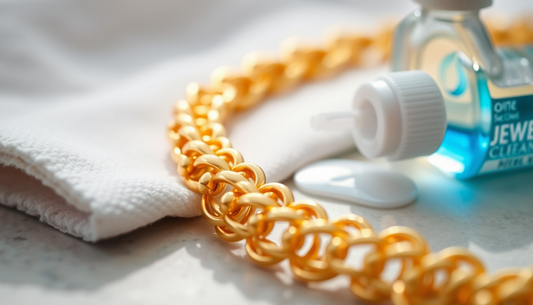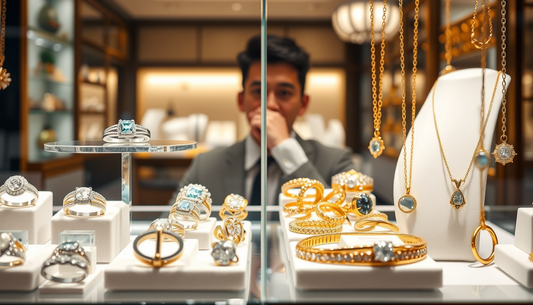
How White Gold is Made: A Journey Through the Manufacturing Process
Share
What is White Gold and How is it Made?
White gold is an increasingly popular gold alloy in modern jewelry, renowned for its refined and shiny appearance. Unlike yellow gold, white gold offers an elegant and sophisticated touch, ideal for those looking for exclusive and high-quality jewelry. But what makes this material so special? In this article, we break down each stage in the white gold manufacturing process, from metal extraction to final finishes.
What is White Gold?
White gold is a combination of pure gold with other metals such as palladium , platinum or nickel , which give it its characteristic light tone. These metals not only contribute to the color, but also to the durability of the material, making white gold strong and long-lasting, ideal for everyday jewelry and engagement rings.
White Gold Manufacturing Process
1. Gold Extraction and Refining
Gold is mined from mines around the world and is found in the form of nuggets or veins. The mining process involves specialized techniques that seek to extract the metal without polluting the environment. After extraction, the gold undergoes a refining process to remove impurities, thus achieving greater purity that allows for a more uniform alloy.
2. Creation of the White Gold Alloy
Pure 24-carat gold is a deep yellow color. To make it white gold, it is mixed with other precious metals such as palladium, platinum or nickel. This alloy determines the shade of white gold, which can vary between bright white or soft gray, depending on the amount of each metal added. White gold jewelry usually has a content of between 10% and 25% of metals such as palladium or platinum, which also influences its cost and durability.
3. Casting and Laminating
Once the alloy is created, the material is melted and forms white gold ingots. These ingots are rolled and stretched into sheets or wires of different thicknesses. This process is essential to adapt white gold to different styles of jewelry, from delicate rings to robust necklaces.
Manufacturing of White Gold Jewelry
The making of white gold jewelry is a meticulous process that begins with a precise design and culminates in a masterpiece. Here we show you each key stage:
1. 3D Design and Modeling
The making of each piece of jewelry begins with a sketch or digital design. Thanks to 3D modeling technology , designers can visualize and adjust every detail before proceeding. This step allows pieces to be customized to the customer's wishes, creating unique rings, bracelets and necklaces.
2. Casting and Molding
After the piece has been designed, the white gold is melted again and poured into moulds that will shape the jewel. This stage requires precision and skill, as the temperature and cooling time influence the final result.
3. Finishing and Polishing
Once molded, each piece undergoes a meticulous finishing process. At this stage, the jewel is sanded and polished to remove any imperfections and give it its characteristic shine. This step not only adds beauty to the piece, but also protects it, increasing its resistance to scratches and wear.
4. Rhodium Coating
To maximize the brilliance of white gold, many pieces are coated with a thin layer of rhodium , a metal belonging to the platinum family, which accentuates the color and durability of the jewelry. Although this coating can wear off over time, it is easy to replace to restore the original shine.
Why is White Gold so Valued?
White gold is not only known for its elegant appearance, but also for its versatility. This metal is a popular choice for engagement rings , wedding bands , and luxury jewelry pieces. Unlike other alloys, white gold is resistant to wear and tear and pairs well with precious stones such as diamonds, highlighting their natural shine.
How to Care for White Gold Jewelry
To preserve the shine and durability of white gold, it is important to follow certain precautions:
- Regular Cleaning: Use a soft cloth and warm water with mild soap to clean the piece. Avoid harsh chemicals that may damage the rhodium plating.
- Proper Storage: Store jewelry in individual cases to avoid scratches.
- Periodic Inspections: Take your white gold jewelry to a professional jeweler for an annual cleaning and polishing.
White Gold vs. Yellow Gold: Which is the Best Option?
The choice between white gold and yellow gold depends on personal preference and style. Yellow gold is associated with a more classic look, while white gold is ideal for those seeking a modern and sophisticated appearance. Both are durable options and can be adapted to any type of jewelry, but white gold is often preferred in pieces such as engagement rings and contemporary designer jewelry.
Frequently Asked Questions about White Gold
Why is white gold more expensive than yellow gold?
White gold is usually more expensive due to the inclusion of precious metals such as palladium or platinum and the rhodium plating process, which provides strength and shine.
Is it necessary to rhodium-coat white gold?
Yes, rhodium plating is common to enhance the appearance of white gold and protect it from tarnish. Over time, it can wear off, but it can be easily reapplied.
Is white gold hypoallergenic?
Some white gold alloys containing nickel may cause reactions in sensitive individuals. However, alloys containing palladium or platinum are generally hypoallergenic.



